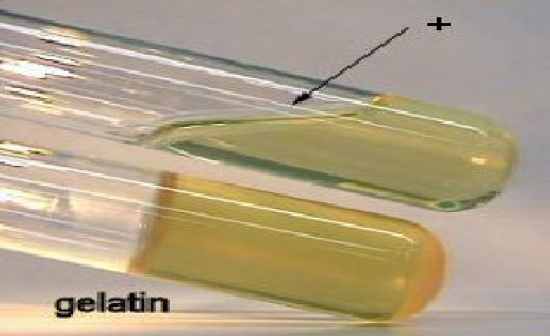
Gelatin hydrolysis test
Objective:
- to test whether the organism produces gelatin hydrolyzing enzyme gelatinase or not
Principle:
The main purpose of this test is to detect the ability of organism to produce enzyme gelatinase. Gelatin is a globular protein that is produced by hydrolysis of collagen. Collagen is the major component of connective tissues and tendon I humans and animals. Gelatin dissolves in water at 50°C and exist in liquid form above 25°C and solidifies as gel below 25°C. Once the gelatin is hydrolysed, even 4°C temperature cannot restore gel like characteristic. Gelatin is polymer of aminoacids linked by peptide bonds. The presence of gelatin protein is detected by adding acidic HgCl2 (mercuric chloride). HgCl2 forms white precipitate with gelatin protein. The microorganism producing an extracellular gelatinase hydrolyses gelatin releasing constituent aminoacids and short peptides. These aminoacids are then utilizes by microorganisms. HgCl2 does not give white precipitate with aminoacids, so the microorganism which hydrolyses gelatin give no white precipitation with HgCl2.
Requirements:
- Media: 1% gelatin agar
- Mercuric chloride (HgCl2)
- Culture: 24 hours culture of Bacillus spp and coli
Procedures:
I. Gelatin hydrolysis test in agar plate
- Prepare agar media with 1% gelatin
- Inoculate the gelatin agar plate with the given organism ( coli and Bacillus in separate plate) using inoculating loop making single central streak in the plate.
- Incubate the plates at 37 °C for 24-48 hours.
- Flood the plates with HgCl2 solution.
- Observe the plates after few minutes. A clear halo-zone around the inoculated area indicates gelatin hydrolysis; positive test.

II. Gelatin hydrolysis test in tube
- Prepare gelatin media in test tube
- Inoculate the gelatin tube with given organism by stabbing the media multiple time using inoculating wire.
- Incubate the tube at room temperature (25°C) for 24-48 hours.
- After incubation for 24-48 hours, place the tube in refrigerator for 30 minutes at 4°
- Observe the tube for gelatin hydrolysis. The hydrolyzed tube remain liquid even after freezing at 4°C

| Gelatin hydrolyzing bacteria | Gelatin non-hydrolyzing bacteria |
| Serratia, Proteus, Staphylococcus aureus, Bacillus spp, Clostridium spp, Pseudomonas | Members of Enterobactericeae family, Staphylococcus epidermidis |
